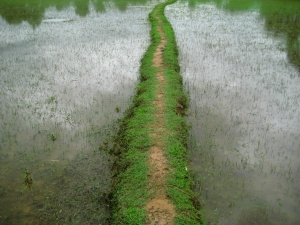Dr Rolando T. Cruz, a senior scientist from the Philippine Rice Research Institute (PhilRice), the Philippines’ lead agency in rice research and development, is in Australia for 12 months researching how to improve the yield of rice crops that rely on rain.
He is a Visiting Academic at the EH Graham Centre for Agricultural Innovation – a collaborative alliance between CSU and Industry & Investment NSW in Wagga Wagga in regional Australia.
"This international project to improve the survival of non-irrigated or rain-fed rice crops during drought is ultimately about finding a way to improve the yield of rice when water is limited," Dr Cruz said.
"Unlike previous studies focussed on drought tolerance traits, this project is examining drought avoidance traits and the rice plant’s ability to maintain its water by increased root uptake. We want to produce rice lines which are able to perform better under drought conditions.
"While Australia is familiar with water shortages, it is also a serious problem for south and south east Asia where more than 50 per cent of the rain-fed rice areas are prone to drought.
"The international project, Improving drought avoidance root traits for enhanced productivity of rice under water-limited environments, is funded by the Generation Challenge Programme (GCP) of the Consultative Group for International Agricultural Research (CGIAR)."
Working with Dr Cruz in Australia on the project is Strategic Research Professor of Farming Systems and Crop Physiology at CSU and a senior member of the EH Graham Centre, Len Wade. Lecturer with the University’s School of Agricultural and Wine Sciences and root expert, Dr Sergio Moroni is also part of the team.
"With the world population set to increase and limited farm land, food security is a global priority," Professor Wade said. "Crops that can overcome soil hardness and make more efficient use of available soil water are urgently needed. This would stabilise and increase production of our staple grains, especially rice - the staple food for the poorest people in many developing countries of Asia, sub-Saharan Africa and Latin America.
"As rice is a model cereal suitable for detailed study, this project will also have implications for the farming of wheat under drought, the mainstay of Australia’s agricultural crop production, and related research is being conducted."
Pots galore
Part of Dr Cruz's research at Charles Sturt University in Wagga Wagga has focussed on measurements taken from 120-specially designed PVC pots containing a variety of rice lines. As part of his research, Dr Cruz specially designed and then constructed about 120 pots from PVC or polyvinyl chloride. Two wax layers, which vary in hardness to mimic hard soil in drought conditions, were placed at 20 centimetres depth in the sandy loam soil in the PVC pots. Rice varieties are then planted in the pots.
Initially, 35 rice varieties and lines were screened by Dr Cruz for their ability to grow roots through an artificial hardpan and to extract water from depth in a drying soil. For the PVC pot study, two contrasting lines from the 35 varieties and lines, are studied in more detail.
The rice is watered for several weeks and then denied water for about the same period in the growth chamber at the National Wine and Grape Industry Centre at Charles Sturt University. Light levels, temperature and humidity are controlled through the use of the growth chamber. Dr Cruz closely observes and measures leaf growth, soil and plant water status, soil and wax layer hardness, the ability of the root to penetrate the wax layers and adjust to water deficit, and ultimately the plant yield.
"One of the challenges is to measure the roots. Very, very few people in the world have the skills of Dr Cruz in sampling and measuring root osmotic adjustment, the adjustment in roots at cellular level under water deficit."
Later on, the two contrasting rice lines being studied in the growth chamber will be examined in the University’s underground field laboratory known as a Rhizolysimeter. The facility allows roots to be viewed and water extraction to be monitored continuously and non-destructively.
International links
As an agronomist and crop physiologist with PhilRice, Dr Cruz is used to working away from home. He completed his PhD in agronomy and crop/plant physiology at Texas A&M University in the USA in 1991 and undertook post-doctoral research at Michigan State University in the subsequent years. He has also undertaken scientific visits to institutions in Japan, Israel, India and China.
The 10-year General Challenge Programme involves an international consortium of researchers assembled to provide a range of skills from plant breeding, agronomy and soil science to genetics, physiology and molecular biology for crop improvement.
"Charles Sturt University has responsibility for the research to better understand how roots can grow through drying and hardening of soils, and hence, what characteristics should be incorporated to result in plants better adapted to water deficit," Professor Wade said.
"This multi-disciplinary partnership is making progress in developing lines with improved performance under drought, which farmers usually regard as their number one and most difficult problem.
"In Asia, rice encounters too much and too little water during the same season, much as wheat encounters in southern Australia. Hence adaptive traits from one have application to the other."
In September, Professor Bob Sharp - an international authority on the impact of water scarcity on root growth - visited CSU in Wagga Wagga from the University of Missouri in the USA. He spent time with Professor Wade, discussed research approaches and visited Dr Cruz’s experiments.
Professor Sharp is one of the key collaborators on this project. The Generation Challenge Programme also involves other researchers from Scotland, Japan, India and Africa.
"It’s fantastic to have so many interested parties working together in an effort to deal with the global issues of drought, climate change and food security," Professor Wade said. "I am excited about the results, which clearly demonstrate that roots of rice lines differ in osmotic adjustment capacity under water deficit."

